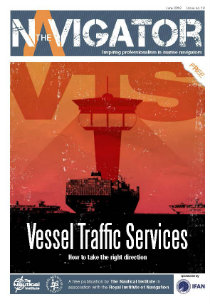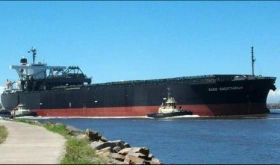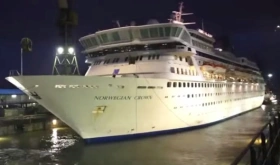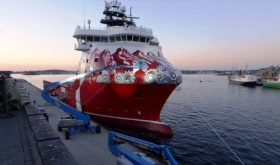During the morning of 18 January 2007, when on passage in the English Channel, the 4419 TEU container ship MSC Napoli encountered heavy seas, causing the ship to pitch heavily. The ship was making good a speed of 11 knots and the height of the waves was up to 9m. At about 1105, the vessel suffered a catastrophic failure of her hull in way of her engine room. The master quickly assessed the seriousness of the situation and decided to abandon ship. Following the broadcast of a distress call at 1125, the 26 crew abandoned the vessel in an enclosed lifeboat. They were later recovered by two Royal Navy helicopters. There were no injuries.
MSC Napoli departed her berth in Antwerp at 0812 on 17 January 2007. The weather worsened overnight, and a deck log entry made during the 0400-0800 watch stated “Vessel rolling and pitching moderately, vessel pounding heavily at times. Seaspray over focsle”. By the time MSC Napoli was about 45 miles south east of the Lizard Point in Cornwall, England she was heading into storm force winds. The vessel was occasionally pitching heavily into high seas but was no longer rolling to any significant extent. Her course was 240º and her engine was at a speed which normally resulted in a vessel speed of 17kts3. She was making good a speed of 11 knots over the ground.
Shortly after 1100, the ship encountered several large waves, which were described as “quite powerful strikes”. One of the crew found it extremely difficult to stand in a shower cubicle during this period due to the vessel’s movement. At about 1105 a loud crashing or cracking sound was heard. At the same time, the third assistant engineer, on watch in the engine control room (ECR), acknowledged an alarm indicating a high level of fluid in the engine room bilge. This was immediately followed by further bilge alarms and an engine room flood alarm.
The first assistant engineer quickly joined the third assistant engineer in the ECR. He telephoned the chief engineer on the bridge and informed him of the situation, while the third assistant engineer went to the bottom plates in the engine room to investigate the cause of the alarms. On arrival, the third assistant engineer saw water spraying from the general service (GS) pump delivery pipe just forward of the main engine. The pump was not running and he quickly shut both its delivery and suction valves. This stopped the water flow. The delivery pipe had sheared cleanly across, and the two sections had separated by about 150mm. The third assistant engineer also saw a large quantity of water sloshing from side to side under the engine room bottom plates. As he started to return to the ECR, the tank top forward of the main engine appeared to open up across the ship, and a “wall of oily water” shot upwards before cascading down across the pump flat and bottom plates. The third engineer quickly evacuated the area and returned to the ECR.
Following the call from the first assistant engineer, the chief engineer informed the master that the engine room might be flooding. He then quickly made his way to the ECR, where the third assistant engineer briefed him on what he had seen. The chief engineer went down to the bottom plates to assess the situation. He saw a lot of water swirling across the tank tops and under the bottom plates and, what appeared to be cracks, in the tank top. He also saw what he thought was a large fracture in the side shell plating on the starboard side close to the sea chest. Additionally, many of the cooling pumps in the pump flat had stopped operating. The chief engineer stopped the main engine before returning to the ECR, from where he informed the master of the situation. Having concluded that the ship had suffered serious structural failure, he then ordered all personnel to leave the engine room.
After talking to the chief engineer, the master went onto the starboard bridge wing from where he could see that the ship’s side plating directly below the bridge was bulging outwards. He also saw what appeared to be a vertical fracture below the waterline as the ship rolled to port. When similar damage was seen on the port side, the master assessed that MSC Napoli had ‘broken her back’, and decided to abandon the vessel.
A distress message was sent via MF DSC at 1125 and the crew started to assemble on the bridge. A few minutes later, the vessel lost all electrical power. However, lighting was soon restored when the ship’s emergency generator started automatically. By now, the ship was stopped in the water, with her starboard side exposed to the wind and sea. Consequently, the master sent the bosun and three of the crew to prepare the port lifeboat for launch. Others were sent to the provision locker to get cases of bottled water. After all crew had been accounted for, the master sounded the emergency alarm of seven long, and one short blasts on the ship’s whistle to indicate to the crew to make their way to the lifeboat station. He then called Ushant Traffic on VHF radio to advise that he and his crew were abandoning into the lifeboat.
The master and third officer were the last to enter the lifeboat, having collected the SART, EPIRB and a number of the ship’s documents. The lifeboat engine had been started and, following verbal confirmation from the chief officer that all 26 crew members were on board, the master ordered the chief engineer to lower the lifeboat by hauling down on the remote lowering wire. The lifeboat smoothly descended the 16 metres to the sea. Once waterborne, the bosun released the fore and aft falls from inside the lifeboat. However, the crewman sitting nearest the forward painter release could not pull the release pin sufficiently far to allow the painter to disengage. He was squeezed between two other crew and his movement
was restricted by his immersion suit. The painter was eventually cut by the chief engineer, who had a knife, and was able to reach the painter via the lifeboat’s forward hatch.
After clearing MSC Napoli, the lifeboat was manoeuvred to a position between 1 and 1½ miles away from the stricken vessel. The master then activated the EPIRB and the SART. The motion of the lifeboat was violent and the atmosphere in the lifeboat was very uncomfortable; all of the crew suffered from sea sickness. Although the lifeboat was certified to accommodate up to 32 persons, the 26 crew wearing immersion suits and lifejackets were very cramped. They were very warm and several felt faint and de-hydrated. The situation became more tolerable after the crew cut off the gloves from their immersion suits with the chief engineer’s knife. This allowed them to use their hands more effectively, and they were able to drink from plastic drinking water bottles they had brought with them.
On receipt of the “Mayday”, CROSS Corsen initiated the assistance of a SAR helicopter and a tug. When the crew abandoned, Falmouth MRCC was also requested to assist. Falmouth MRCC activated two SAR helicopters, R193 and R194. The first helicopter arrived at the scene at 1150. Initially, a highline could not be passed to the lifeboat due to the severe weather conditions. However, at about 1230, a diver was lowered from R194 into the sea and swam to the lifeboat. A highline was rigged and the helicopter crew recovered 13 survivors from the lifeboat. R193 took over the winching operation at 1325, and by 1409 the remaining 13 survivors had been recovered.
Following the successful abandonment of the vessel, MSC Napoli was taken in tow to Portland, Dorset. A towline was connected but, as the disabled vessel approached the south coast of England, concern increased regarding her condition. In order to prevent the vessel from breaking up or sinking at sea, she was beached in Branscombe Bay on 20 January 2007. A number of containers were lost overboard when the vessel listed heavily after beaching.
During the following 5 months, most of the vessel’s fuel oil and the remaining containers were removed. MSC Napoli was refloated on 9 July 2007, but it was soon apparent that she was in a poor condition and she was re-beached 3 days later. On 20 July 2007, the vessel was separated using explosive charges approximately in way of where the hull had failed on 18 January 2007. The forward section was then towed to the Harland and Wolff shipyard in Belfast for recycling.
According to relevant MAIB report the following recommendations have been made:
- The effect of the discrepancies in the declared weights of the containers would not have been sufficient to cause hull failure, but it would have contributed to the reduction of the safety margin between the total bending moment experienced and the strength of the hull.
- Although it is likely that the wave loading experienced by MSC Napoli was increased by whipping effect, classification societies are unable to predict its magnitude or effect on a ship’s structure with any confidence.
- In view of the potential increase in wave loading due to whipping effect, further research is required within the industry to ensure that the effect is adequately covered by ship design and structural analyses, and that sufficient allowance is made for the effect when determining a design margin.
- As the area of the hull which failed was outside of the 0.4L amidships area, the applicable classification society rules did not require the buckling strength of the hull in this area to be checked. Therefore the buckling strength of the hull in way of the engine room was not calculated by either the ship builder or BV.
- The transverse framing in the engine room of MSC Napoli was an inherently weak structure when under compressive loading.
- It is apparent that UR S11 has lagged behind the development of container ship design and operation, and requires immediate revision. Buckling checks must be based on global hull stresses along the entire length of the hull and not left to the discretion of individual societies. The use of common methodologies in this respect would provide greater assurance that the strength of all new build container ships is being adequately addressed.
- In view of the importance of the design safety margin in ensuring an acceptable level of safety, a more objective approach is warranted.
- Given the importance of speed with regard to wave loading and whipping effect, research into the provision of hull stress monitoring and/or vessel motion sensing on container ships should be considered.
- Although the vessel’s speed was considered to be appropriate in the conditions experienced, it is almost certain that a reduction of speed would have significantly reduced the risk of hull failure.
- The stresses acting upon a container ships hull cannot be accurately controlled unless containers are weighed before embarkation.
- It is possible that the requirement to report structural damage, including fatigue cracking and weld repairs on main structural members, to classification societies is either not fully understood or is occasionally overlooked.
- Although it is debatable whether or not the defect to the main engine governor was critical to the safe operation of the vessel, had the ship manager discussed the status of the defect with the classification society, this might have allowed a more informed consideration of its consequences when deciding if the vessel was in a fit material state to sail from Antwerp.
- Despite the potentially adverse effect on the manoeuvrability of the vessel in restricted waters, the pilot was not informed of the defect to the main engine governor.
- The practice of arriving and departing from berths, in a loaded condition that was in excess of permissible seagoing maxima, was potentially detrimental to safety but is commonplace within the container ship industry.
- As a result of the screening of over 1500 container ships by their respective classification societies, 12 vessels were identified as being potentially vulnerable to localised buckling in severe conditions and requiring remedial action.
- The commercial advantages of containerisation and intermodalism such as speed and quick turnarounds appear to have become the focus of the industry at the expense of the safe operation of its vessel.
In view of the potential vulnerability of other container ships of a similar design, the MAIB requested the major classification societies to conduct urgent checks on the buckling strength of a number of ship designs. Over 1500 ships were screened, of which 12 vessels have been identified as requiring remedial action; a further 10 vessels were identified as being borderline and require more detailed investigation; and the screening of 8 container ships was still in progress at the time of publication.
Recommendations have been made to the International Association of Classification Societies, which are intended to increase the requirements for container ship design, consolidate current research into whipping effect, and to initiate research into the development and use of technological aids for measuring hull stresses on container ships. Recommendations have also been made to the International Chamber of Shipping with the aim of promoting best practice within the container ship industry, and to Zodiac Maritime Agencies, with reference to its safety management system.
Source: MAIB



















Leave a Comment